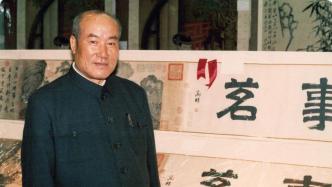
Mr. Liu Jiu'an (1915-1999) has been engaged in the appraisal and research of ancient calligraphy and painting for more than 70 years. He twice participated in the "Chinese Ancient Calligraphy and Painting Appraisal Group" organized by the State Administration of Cultural Heritage and has identified and appraised more than 60,000 pieces of ancient calligraphy and painting.
The Paper has learned that on December 7, the “Documentary Exhibition in Commemoration of Mr. Liu Jiu’an and the 30th Anniversary of the Founding of the Ancient Chinese Painting and Calligraphy Appraisal Discipline” was held at the Pan Tianshou Memorial Hall in Hangzhou. The exhibition presents the development process of the subject of Chinese calligraphy and painting appraisal, demonstrates the enthusiasm and rigorous scholarly spirit of Pan Tianshou, Liu Jiu'an and other older generation artists and scholars for the appreciation and research of Chinese calligraphy and painting, and emphasizes that calligraphy and painting appraisal is an important prerequisite for academic research. .
Appraisal and creation are both important links in artistic activities and play a key role that cannot be ignored. As a master who insisted on the characteristics of national painting in the 20th century, Mr. Pan Tianshou has conducted in-depth research and exploration in the aspects of pen and ink language, painting ideas, art education, and appraisal of calligraphy and painting. In the 1950s, Pan Tianshou, Wu Fuzhi, Zhu Lesan and others jointly purchased ancient paintings scattered among the people for the East China Branch of the Central Academy of Fine Arts (later renamed Zhejiang Academy of Fine Arts, the predecessor of the China Academy of Art) for teaching and For research purposes, the next batch of valuable calligraphy and painting collections will be preserved for the school. In 1987, Mr. Liu Jiu'an visited Hangzhou to conduct appraisal and analysis on the calligraphy and painting works collected by Zhejiang Academy of Fine Arts at that time, and left records in "Liu Jiu'an's Painting and Calligraphy Appraisal Research Notes". Pan Tianshou and Liu Jiu'an have both made important contributions to the collection of calligraphy and painting and discipline construction of the China Academy of Art. They have also transcended time and space and gathered together in the historical context of inheriting national art and promoting national culture.

Mr. Liu Jiu'an is in Wenlan Pavilion, Hangzhou

Mr. Liu Jiuan waved a brush
This exhibition brings together Liu Jiu'an's remaining work notes, photos, videos, calligraphy, singing, calligraphy and painting works, letters from friends, and important collections from his lifetime. It is hoped that through this document exhibition, Liu Jiu'an's lifelong academic path will be restored to encourage future scholars.
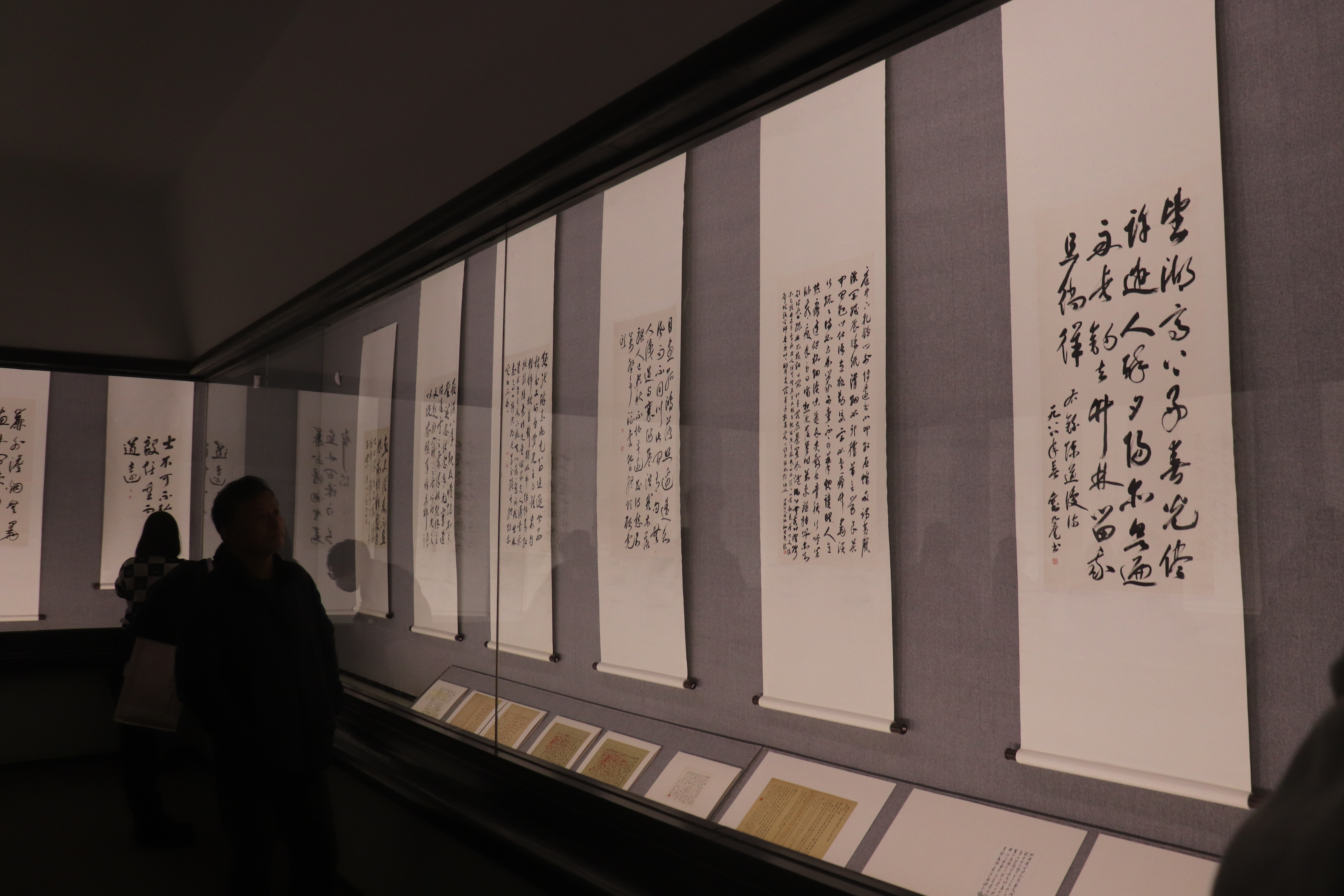
exhibition site

exhibition site
Accumulated more than 3 million words of appraisal notes
42 years of in-depth research and breadth
In 1956, Liu Jiu'an, who had great eyesight, entered the Palace Museum on the recommendation of Chen Banding, where he engaged in calligraphy and painting appraisal, collection, and research. In 1958, Liu Jiu'an went out for appraisal for the first time. He went to the Anhui Provincial Museum and the Political Department of the Logistics Department of the Wuhan Military Region to authenticate calligraphy and paintings. A batch of calligraphy and paintings from the Wuhan Military Region were seized by unscrupulous businessmen during the early days of liberation when they planned to smuggle them out of the country. When Liu Jiu'an arrived, some of the works had already been selected. Liu Jiu'an had a unique eye and found a "Ming Dynasty figure painting on silk" among the pile of "mostly fake and shoddy goods". He went through the donation procedures and took it back to the Forbidden City, and changed the order. It is a painting of the Southern Song Dynasty, officially named "Blind Picture of a Group in the Willow Shade", and has become a national first-class cultural relic.
Liu Jiu'an has been engaged in the appraisal and research of ancient calligraphy and painting for more than 70 years, and has made remarkable achievements and outstanding contributions: he twice participated in the "Chinese Ancient Calligraphy and Painting Appraisal Group" organized by the State Administration of Cultural Heritage, and traveled across the country to identify and appraise more than 60,000 ancient calligraphy and paintings. While at the Palace Museum, Liu Jiuan, together with Xu Bangda, Zhu Jiaxin and others, carried out the appraisal, collection and research of ancient calligraphy and painting. They reorganized and reviewed the ancient calligraphy and paintings collected in the Palace Museum, created a new scientific identification method, and laid the disciplinary foundation for the research on the identification of ancient calligraphy and paintings in the Palace Museum.
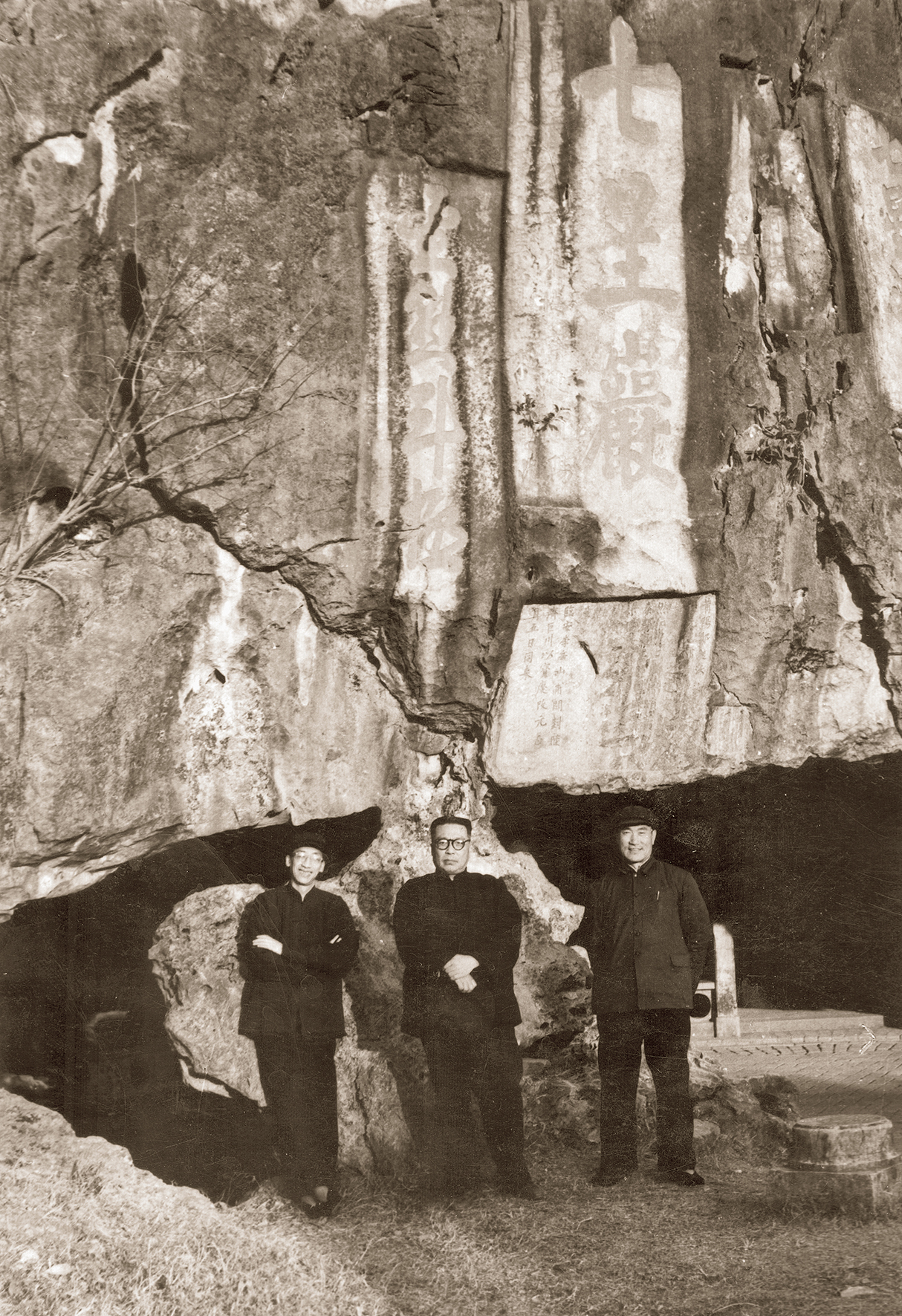
Zhang Heng, Xie Zhiliu and Liu Jiu'an at Qixingyan in Guangzhou (the first one on the right is Liu Jiu'an)
From 1956 to 1997, Liu Jiu'an wrote a total of 269 volumes of ancient calligraphy and painting appraisal experiences, work diaries, eye-catching descriptions of calligraphy and painting, excerpts of relevant literature, and collection of materials on research topics. The context is clear and the system is complete. In 2020, it was published by the Forbidden City Published by the publishing house, it plays an important role in promoting the appraisal of ancient Chinese calligraphy and painting and the study of Chinese art history. For example, the discovery of the authentic copy of Zhao Mengfu's "Scroll of Du Fu's Poems in Running Script" at the Xinxiang City Museum in Henan, and the analysis of ghostwriting, alterations, and forgeries in ancient calligraphy and painting are all recorded in detail in Liu Jiu'an's notes.
Liu Jiu'an has written more than 40 articles on calligraphy and painting appraisals, including two about Zhao Mengfu. When he went to Henan for appraisal, he also discovered an authentic copy of Zhao Mengfu's "Du Fu's Poetry Scroll in Running Script". This work was collected in the Xinxiang Municipal Museum in 1958, and was cleared and archived in 1979. The local government invited Liu Jiu'an to guide the work. Liu Jiu'an recorded the discovery process in his "Working Diary of the Xinxiang Museum": "I went to the museum's warehouse to read calligraphy and paintings in the morning and afternoon. Most of them were works by Qing Dynasties. The recommended scroll "Okra" by Qian Xuan of the Yuan Dynasty was originally by Tang Yin, a pseudo-Ming Dynasty. The poems and paintings were inscribed, and later Qian Xuan's inscription was added, with the title of Tang Dynasty. However, among the tatters of the mounting work, a scroll of "Five Rhymed Poems in Running Script and Large Characters" by Zhao Mengfu of the Yuan Dynasty was found. This is indeed an unprecedented piece. What comes to mind is that it was a pioneering calligraphy work in his later years. There is a small running script postscript by Liang Guan on the upper frame. The scroll with Zhao characters has not yet been seen in various museums. There are still different opinions on the scroll collected by the Shanghai Museum. This is not only the case in various museums in Henan Province. There is none, and there are none in other provincial and municipal museums, so it can be called a rare item among Zhao Mengfu's scrolls." Liu Jiu'an designated this work as a rare item among Zhao Mengfu's standing scrolls.

Yang Renkai, Liu Jiu'an, Xie Zhiliu and others appreciate cultural relics (second from left is Liu Jiu'an)
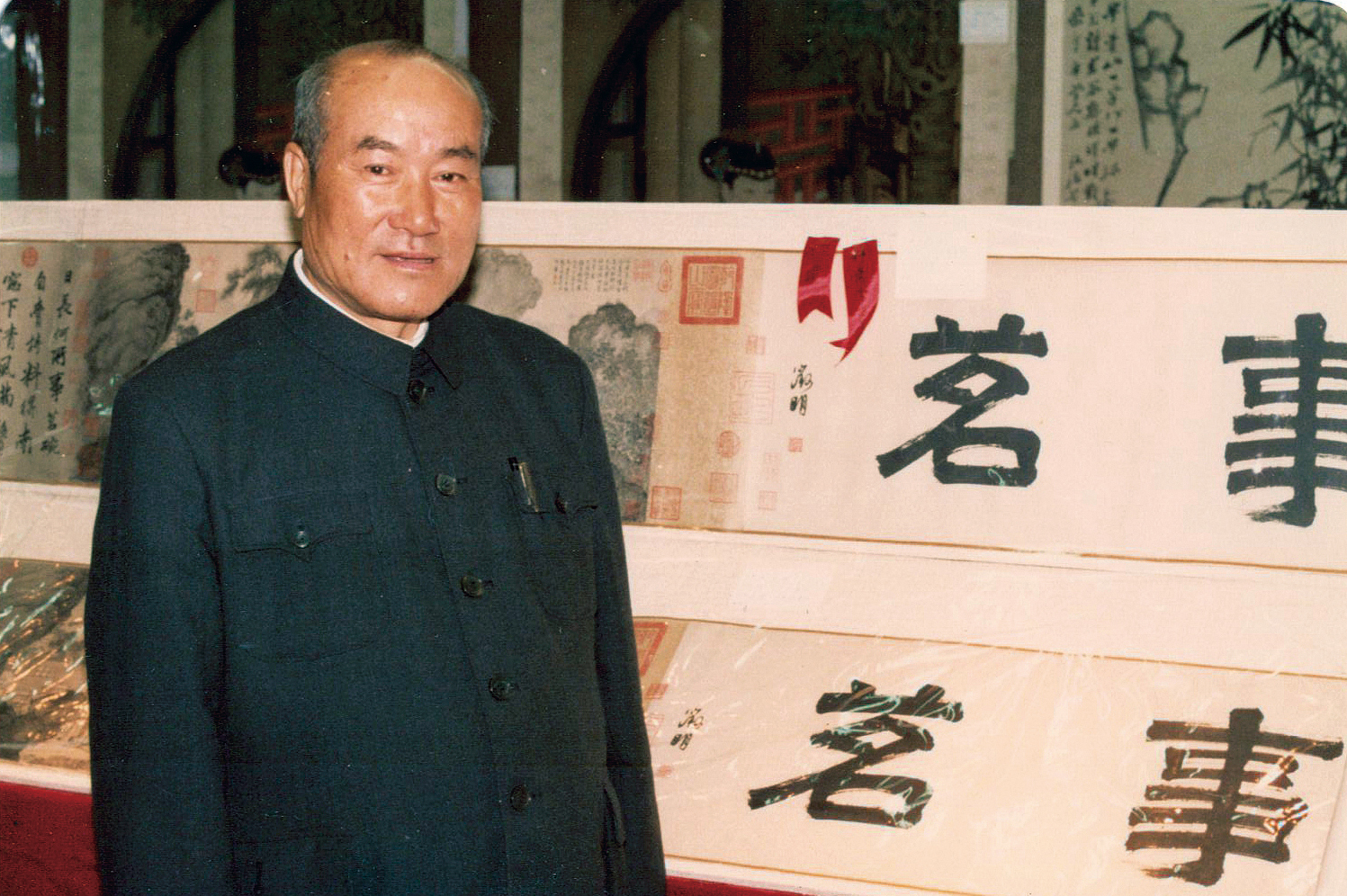
Mr. Liu Jiu'an hosted the "Authenticity Comparison Exhibition of Chinese Calligraphy and Paintings from Past Dynasties" and took a photo
The "Leon Yu Tie" collected by the Palace Museum is one of the collections of "Song Handbook" and was recorded in Gu Fu's "A Spectacular Life" and Li Zuoxian's "Appreciation of Paintings and Calligraphy" of the Qing Dynasty. The real author of "Leap Yu Tie" is Qiao Xing's bamboo slips of the Southern Song Dynasty. Later generations changed the character "Xing" to "Yi" to impersonate the handwriting of Lu Yixuan's bamboo slips of the Northern Song Dynasty. Liu Jiu'an wrote in his notes: "According to the format of letters in the late Southern Song Dynasty, at the end of this letter there should be the words 'Yue Ri Shao Shi Baoning Army Jiedu Envoy Li Quanxian sent Lu Guogong to become an official Qiao Xing Jian Zazi', because Because this line was lost, later generations did not study the words in the letter carefully, and the signature on the Song Dynasty slip was difficult to identify. I didn't know it was written by Qiao Xingjian, so I thought it was an unknown Song Dynasty handwriting, so I changed it. He has become a famous Lu Yijian."
Liu Jiu'an was also familiar with the forgery of calligraphy and painting during the Republic of China. In his notes on "Surnames of Forgery of Calligraphy and Painting in Modern Times", there are detailed records of the forgers Song Xiaopo, Xu Junqing and Tang An: "Song Xiaopo (Yu), a native of Xuzhou. The courtesy name is Jiang Shijie, Cheng Sui, Ding Yuangong. Xu Junqing, courtesy name Tao Yan, was born in Suzhou. He died after liberation. He specialized in paintings of the Ming and Qing Dynasties, such as the paintings of Nine Friends, Four Kings, Wu Yun, etc. and Dai Xi's paintings. Dai Zhizhen's seal is in his hand. Xu Wei Pang His family members, so all his forgeries have origins. Xu also had an elder brother who died before him. Zhao Shuyan and Xu Zhiqing both purchased a large number of his forgeries. Tang An, also known as Han, courtesy name Lingshi, nickname Linze, Jiaxing A man (now in his 70s) who forged calligraphy and paintings of the Song and Yuan Dynasties. He once created two seal characters, namely Guan Sheng Zhu and Wu Qiu Yan, which were inscribed by Wu Qiu. The Jingya Seal of Xiang Zi in the Ming Dynasty was forged by his hand and is now in the collection of Jibo. He collaborated with Zheng Zhuyou and others. , the seals of Zhang Heng and Tan Jing were both engraved by Tang." Liu Jiu'an's wide knowledge and knowledge can be seen here.
Decades of friendship
Recreating the Cultural Changes of the 20th Century
Liu Jiu'an came to Beijing Liulichang at the age of 14 and first entered the Dunhuazhai antique shop. He studied under Sun Yingzhou and had the same friendship with Geng Baochang. He also worked as an apprentice in Yue Guzhai calligraphy and painting shop for 12 years, forming an indissoluble bond with ancient calligraphy and painting. At the age of 26, Liu Jiu'an sold old calligraphy and paintings on his own, focusing on learning from his peers and drawing on the strengths of each family. After entering the Palace Museum, his acquaintances became even wider. Those who had contact with him included Ma Ziyun, Deng Yizhe, Chen Yuan, Ye Gongchuo, Qin Zhongwen, Han Shenxian, Zhang Daqian, Sha Menghai, Wu Zhongchao, Zhang Heng, Tang Yun, Wang Ji Qian, Huang Yongquan, etc. This exhibition displays letters written to Liu Jiu'an by Xie Zhiliu, Xu Bangda, Qi Gong, Wang Fangyu, Huang Miaozi, Wang Shixiang, Yang Renkai, Wang Shiqing, Zhang Dingchen, Xie Chensheng, Su Gengchun, Li Hanxiang, Zhong Yinlan, Ye Chengyao, Fu Xinian, Zhang Zining, Bai Qianshen and others. , from which we can get a glimpse of cultural changes since the 20th century. Among them, Xu Bangda asked Xu Bojiao's address in Hong Kong, Huang Miaozi recommended Hao Jialin in the letter, and Wang Fangyu mentioned the Badashanren joint exhibition in Nanchang, which are the most direct evidence of Liu Jiu'an's participation in calligraphy and painting appraisal, Sino-foreign exchanges and other matters.

Letters exchanged between Xie Zhiliu and Liu Jiu'an, July 6, 1987

Letters exchanged between Xie Zhiliu and Liu Jiu'an, July 6, 1987
In June 1954, Wu Zhongchao, then deputy secretary-general of the East China Bureau and vice-president of the Party School, was transferred to the Palace Museum as director. When he first took office, there was a shortage of professional talents, which was far from being able to match the vigorous development of the cultural and museum industry at that time. Wu Zhongchao transferred a group of experts with rich experience in cultural relic appraisal from outside the hospital, such as Tang Lan, Wang Yikun, Xu Bangda, Sun Yingzhou, Luo Fuyi, Geng Baochang and others, which greatly enriched the cultural relic sorting and appraisal team. In 1956, Liu Jiuan wrote a letter to Wu Zhongchao through Chen Banding and officially entered the Palace Museum. This exhibition displays the message Wu Zhongchao wrote to Liu Jiu'an in 1959: "May you always work tirelessly for socialist construction and keep making uninterrupted leaps forward! Comrade Liu Jiu'an takes a commemorative note! Wu Zhongchao. February 1959."
Ye Gongchuo is a famous modern social activist, scholar, and collector. After the founding of the People's Republic of China, he successively served as deputy director of the Central Museum of Literature and History and president of the Beijing Chinese Painting Academy. Famous works he has collected include Wang Xianzhi's "Yatou Wan Tie" (collected by the Shanghai Museum), Gao Xian's "Thousand-Character Essay in Cursive Script" (collected by the Shanghai Museum), Song Huizong's "Xianglong Stone Picture" (collected by the Palace Museum), Liang Kai's " "Budai Monk Picture" (collected by Shanghai Museum), Zhao Mengfu's "Dengba Stele in Running Script" (collected by the Palace Museum). After he turned eighty, he donated all his collections of paintings, calligraphy, antiques, and classics to cultural and museum institutions in Beijing, Shanghai, Guangzhou, Suzhou, Chengdu and other places. According to notes, on August 7, 1956, Ye Gongchuo went to the Forbidden City to inspect the collection, and Liu Jiu'an was responsible for the reception. This time on display, Ye Gongchuo wrote "Wanhe Begonia Couplet" written by Liu Jiu'an: "Wanhe communicates with thousands of rocks to compete for beauty, and when the swallows come after the begonias bloom. Mr. Jiu'an belongs to Xia Weng." This couplet is by Ye Gongchuo Direct evidence of his association with Liu Jiu'an.
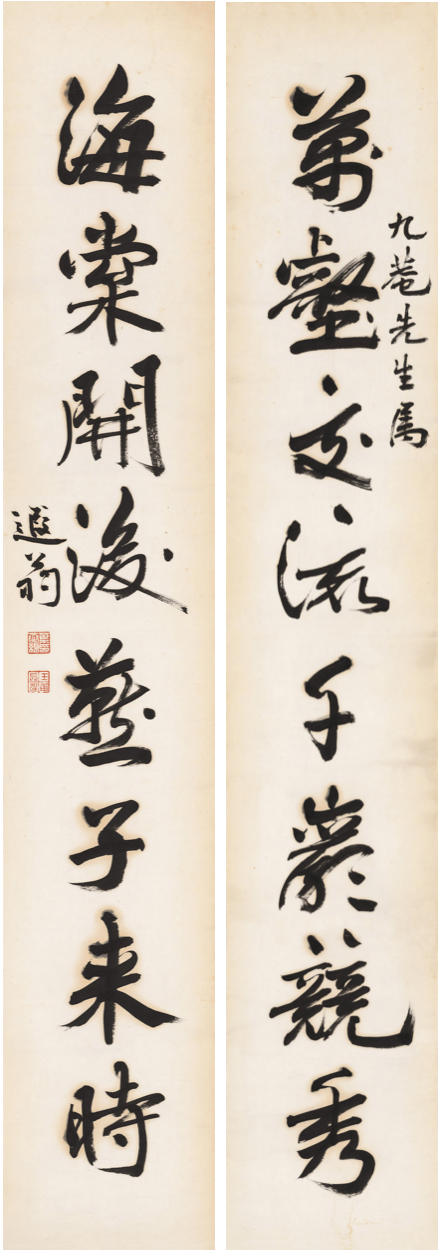
Ye Gongchuo's running script Wan He Begonia eight-character couplet on paper 131cm×23cm×2
Zhang Daqian is a famous modern painter who visited Peiping many times in the 1930s and 1940s. From 1934 to 1936, Zhang Daqian held five art exhibitions in Peking and met Fu Zengxiang, Zhou Zhaoxiang, Puru, Yu Fei'an, Chen Banding and others. After the victory of the Anti-Japanese War in 1945, Zhang Daqian returned to Peiping from Chengdu and lived in the Summer Palace. At that time, there were a lot of "Northeast goods" in Liulichang, and Zhang Daqian was a frequent visitor. Finally, he bought Gu Hongzhong's "Han Xizai's Night Banquet" (collected by the Palace Museum) at Yuchi Shanfang for 500 taels of gold. Liu Jiu'an worked as an apprentice at Yueguzhai in Liulichang in 1930, and started his own calligraphy and painting business in 1942. Zhang Daqian often went to Liulichang, and the two met during this period. It is also true that Liu Jiu'an later wrote "Miscellaneous Notes and Identification of Forgeries of Celebrity Calligraphy and Paintings by Zhang Daqian", which proved that Shi Tao's "Self-written Poems in Running Script" and Shi Xi's "Thousands of Rocks and Paintings" were undoubtedly Zhang Daqian's forgeries. Zhang Daqian's "Avalokitesvara" on display this time was painted in the 1930s, which proves how early the two met.
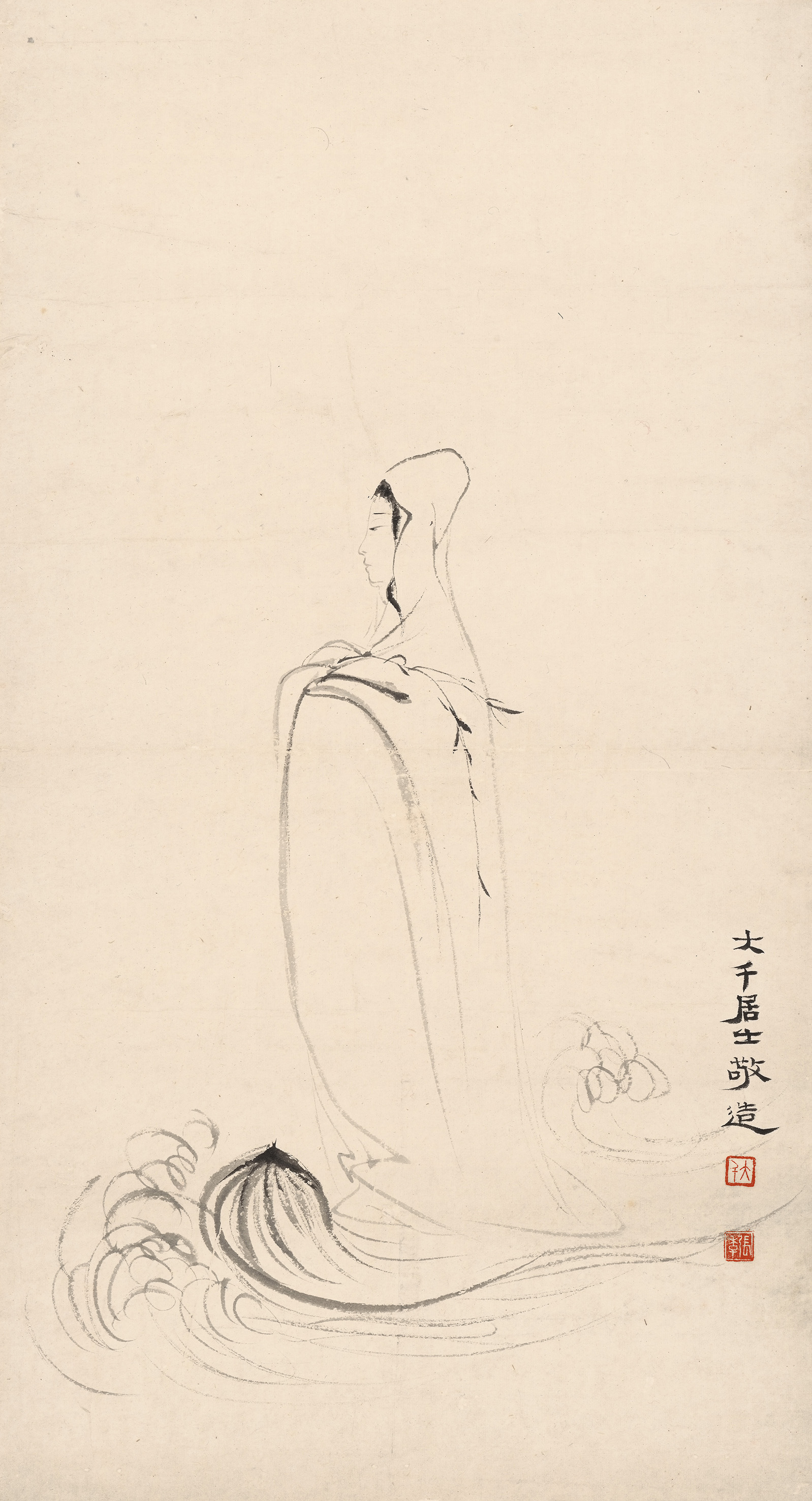
Zhang Daqian Guanyin ink pen on paper 54.5cm×29.5cm
Liu Jiu'an participated in two national calligraphy and painting appraisal tours and had many contacts with Xie Zhiliu. From 1962 to 1964, Liu Jiu'an participated in the appraisal team headed by Zhang Heng. The original members were Zhang Heng, Xie Zhiliu and Han Shenxian. After Han Shenxian passed away, Liu Jiu'an joined. After Zhang Heng passed away, he was replaced by Xie Zhiliu, Liu Jiu'an, and Qigong to continue the appraisal. In 1983, the country once again established a roving appraisal team, of which Xie Zhiliu and Liu Jiu'an were members. They appraised more than 61,000 pieces of ancient calligraphy and painting from 208 ancient calligraphy and painting collection units across the country one by one for seven years. Xie Zhiliu has painted for Liu Jiu'an many times. The ones in this exhibition include "Emei Hua Yan Ding" in 1962, "Ink Lotus Picture" and "Bamboo" in 1984, "Painting Bamboo with Ink Bamboo Song of Yuan Dynasty", and 1990's "Beautiful Coupling of Pearls". Book" etc.
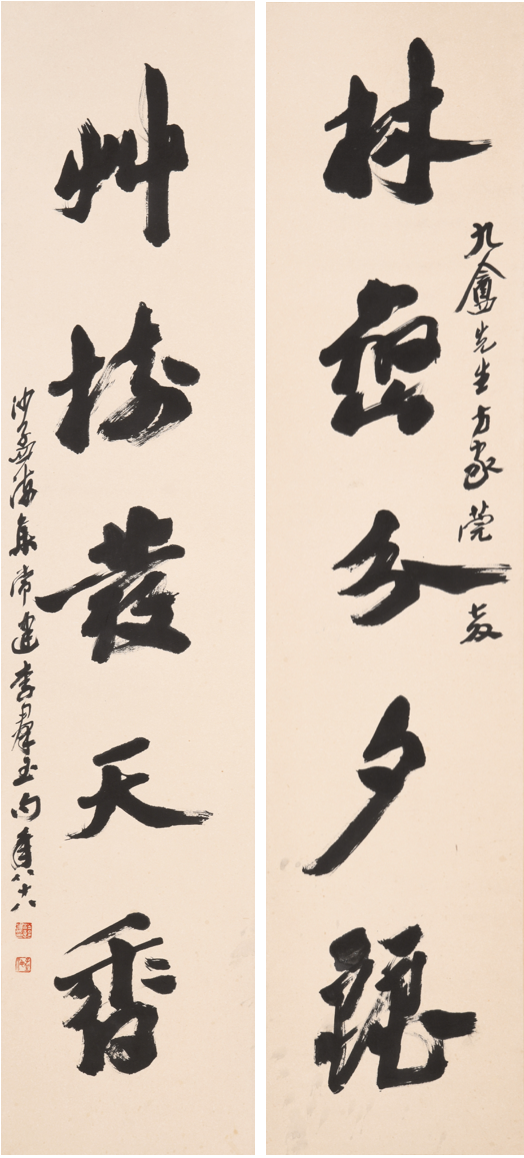
Sha Menghai's calligraphy Five-Character Couplet with Grass and Trees in the Forest, 1987, 100cm×22cm×2
Sha Menghai is a great figure in modern calligraphy circles. He has served successively as the president of Xiling Seal Society, the honorary director of Zhejiang Provincial Museum, and the vice chairman of the Chinese Calligraphy Association. In 1952, Sha Menghai was transferred from Zhejiang University to the Zhejiang Provincial Cultural Relics Management Committee and was hired as a standing committee member and leader of the investigation team, responsible for the investigation and excavation of underground cultural relics. In 1982, Sha Menghai became the honorary director of Zhejiang Provincial Museum. On April 15, 1983, the two had contacts during the Lanting Gathering. In March 1987, members of the appraisal team including Liu Jiu'an, Xie Zhiliu, and Yang Renkai arrived in Hangzhou to authenticate the paintings and calligraphy of the Zhejiang Provincial Museum. It lasted more than a month, and the two had many contacts. On display this time is the "Couplet of Grass and Trees in the Forest and Range" written by Sha Menghai for Liu Jiu'an in 1987: "The forest and range are beautiful at sunset, and the grass and trees are fragrant. Mr. Jiu'an taught in Fang's family in Wanguan, and Sha Menghai collected the jade verses of Chang Jian and Li Qun. , eighty-eight years old.”
high level collection
Donated collections to the Forbidden City
After joining the Palace Museum in 1956, Liu Jiu'an set two rules for himself: first, the remaining ancient calligraphy and paintings from his original business should be donated to the museum free of charge; second, he would not purchase any cultural relics from now on. He donated precious calligraphy and paintings that he had collected for many years, such as "Flowers of the Four Seasons" by Xu Wei in the Ming Dynasty and "Four Admonition Screens in Official Script" by Deng Shiru in the Qing Dynasty, to the Palace Museum and other institutions. This exhibition will display Liu Jiu'an's cultural relics collection, such as Wu Kuan's "Su Shi's "Duan Inkstone Poems" in Running Script", Wang Hao's "Mr. Du's Life Collection Inscription in Heng'an", Zhu Yunming's "Eight Poems of Autumn", and Chen Chun's "Colored Landscape Scroll" , Dong Qichang's "Xiangguang Shusui" volume, Dong Qichang's "Two Inscriptions and Postscripts of Lingu", Dong Qichang's "Snow Ode", Dong Qichang's "Linjin Tang Dharma Notes", Dong Qichang's "On Health", Wang Hui's "Imitation of Liuru Jushi Landscape", Wang Yuanqi "Imitation Plum Taoist Landscape" and other works are masterpieces by famous artists since the Ming and Qing Dynasties.

One of the longevity inscriptions of Mr. Du in the Ming Dynasty, Guoheng'an, 23cm×40.5cm

Ming Wu Kuan's running script on paper 27cm×116cm
Wu Kuan was one of the representatives of the Chenghua and Hongzhi poetry circles in the Ming Dynasty. He was especially famous for his running script and learned from Su Shi. He changed the Taige style of calligraphy since the early Ming Dynasty. He was a member of the "Wumen Calligraphy School" together with Xu Youzhen, Li Yingzhen, Shen Zhou and Wang Hao. Pilot. Xing Dong rated it as: "The elders of Wuzhong are good at friendship, but they are not as good at writing and writing. The calligraphy scholar Su has a thick face, which can eliminate Wu Xi." This volume is from the Wu Dynasty in the second year of Hongzhi (1489). In Beijing, Kuan wrote Su Shi's "Duan Inkstone Poems" for Shengqiuting in Beijing: "In the past years, I drank with Li Xiya and other princes at Xie Muzhai's house, and there were Duanyan couplets. Later I picked up the remaining rhymes and wrote a separate poem. Today, Qiutingjun Shengjun has more and better collections of research. The obtained inscriptions and biographies of the scholar-bureaucrats have become a huge volume, but there are no poems at all, so I recorded the old works and attached them to the later clouds. It was the first day of the sixth month of Jiyou in Hongzhi. I first tried to research it, and I asked Chen Gao to make it in Qiuting." Li Xiya is Li Dongyang, and Xie Muzhai is Xie Qian. The words in the volume are independent but the whole text has a vivid charm. It changes the stylized appearance of Taige style, and sometimes wonderful writing is seen, which shows talent.
Zhu Yunming's cursive calligraphy had a great influence. Together with Wen Zhengming and Wang Chong, he was known as one of the "Three Schools of Wu Chong". Zhu Mounuo, a man of the Ming Dynasty, commented that his cursive calligraphy was the first in the Ming Dynasty: "The study of calligraphy has begun from "Jijiuzhang" to Xi, Xian and Huaisu. Yan Guan, and cursive script is the best in this dynasty." Liu Jiu'an's appraisal of Zhu Yunming's calligraphy in the Ming Dynasty is a classic. He discovered that the forger of Zhu Yunming's calligraphy was Wu Yingmao, and wrote "Zhu Yunming's Xiaokai "Chenghuajian Su Cai Xiaobian" Identification of Forgery" Important articles such as "An Analysis of Zhu Yunming's Cursive Script from Poetry and Fake Calligraphy" have made important contributions to the identification and research of Zhu Yunming's calligraphy. The cursive calligraphy "Eight Poems for Autumn Sing" by Du Fu on display this time was written in the fourth year of Jiajing (1525). It is a wild cursive calligraphy written two years before Zhu Yunming's death. This volume was written by Zhu Yunming in Mengchun's home. Mengchun was Zhu Yunming's friend Yang Qing. Zhu Yunming's "cursive self-written poem" in the Forbidden City can be mutually verified: "In the seventh month of the year of Zhengde Gengchen, I saw Brother Mengchun from the same hall. ". Chen Liu's inscription and postscript named Du Shi and Zhu Cao together as "two masterpieces".

Ming Zhu Yunming's cursive scroll version of Du Fu's "Eight Poems of Autumn" (part of it)
Chen Chun was extremely talented in calligraphy and painting and jumped out of the apprenticeship. Wen Zhengming commented: "I have returned to the profession as a master. He has his own way of calligraphy and painting, and he is not my disciple." On the basis of the flowers of the Wu School, he created his own Ji Zhu integrated cursive brushwork into freehand paintings, creating a new style of freehand flower paintings. Together with Xu Wei, he was known as "Ivy White Sun" and had a great influence on later generations. Chen Chun is also good at landscape painting, which is rare in the world. He occasionally has a unique brush. "Colorful Landscape Scroll" was written in the 19th year of Jiajing (1540). The author was fifty-eight years old. He sketched mountains, rocks, smoked trees, and Taoist people fishing in a carefree style, without being restricted by laws. It was a masterpiece in his later years. During the Ming and Qing Dynasties, it was collected by Xiang Yuanbian, Lu Yanchun and Jingxing.
Dong Qichang started his study of calligraphy from the Tang Dynasty stele, then traced it back to King Zhong, and then looked at the original works of the Song Dynasty. He was especially inspired by the great masters of the past dynasties such as Wang Xizhi, Yan Zhenqing, Li Yong, Huai Su, and Mi Fu. Dong Qichang's highest achievement is running script. His calligraphy is said to be obtained through easy work. His running script is based on the two kings, and the composition is most influenced by Yang Ningshi's "Leek Flower Tie". He also refers to Mi Fu's posture in the Northern Song Dynasty, which is sparse and ethereal, simple and elegant. "Xiangguang Shusui" was written in April of the first year of Chongzhen (1628). This month he and Wang Shimin traveled through Kunshan and saw the Song Dynasty's "Suiyang Five Elders Picture Album" and read Ouyang Xun's cursive and regular script " "Thousand Character Essay", the contents of this volume are poems by Li Bai, Wang Changling, and Tao Yuanming, which are as powerful as ancient times. From it, we can see the effect of his pursuit of maturity before regeneration, which is clumsy yet elegant, reflecting a plain and innocent personality.
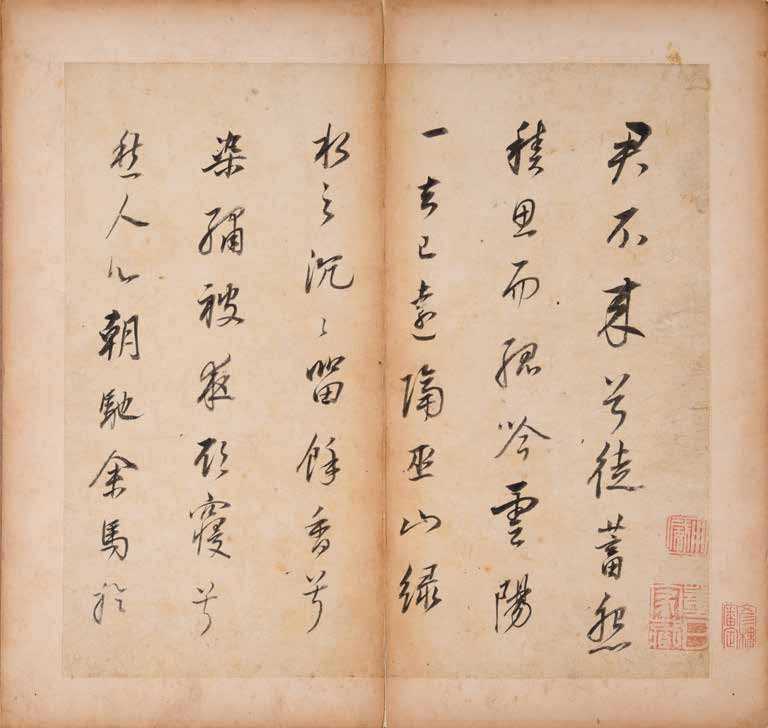
Volume 2 of Xiangguang Paintings by Dong Qichang of Ming Dynasty. Paper 26cm×27.5cm
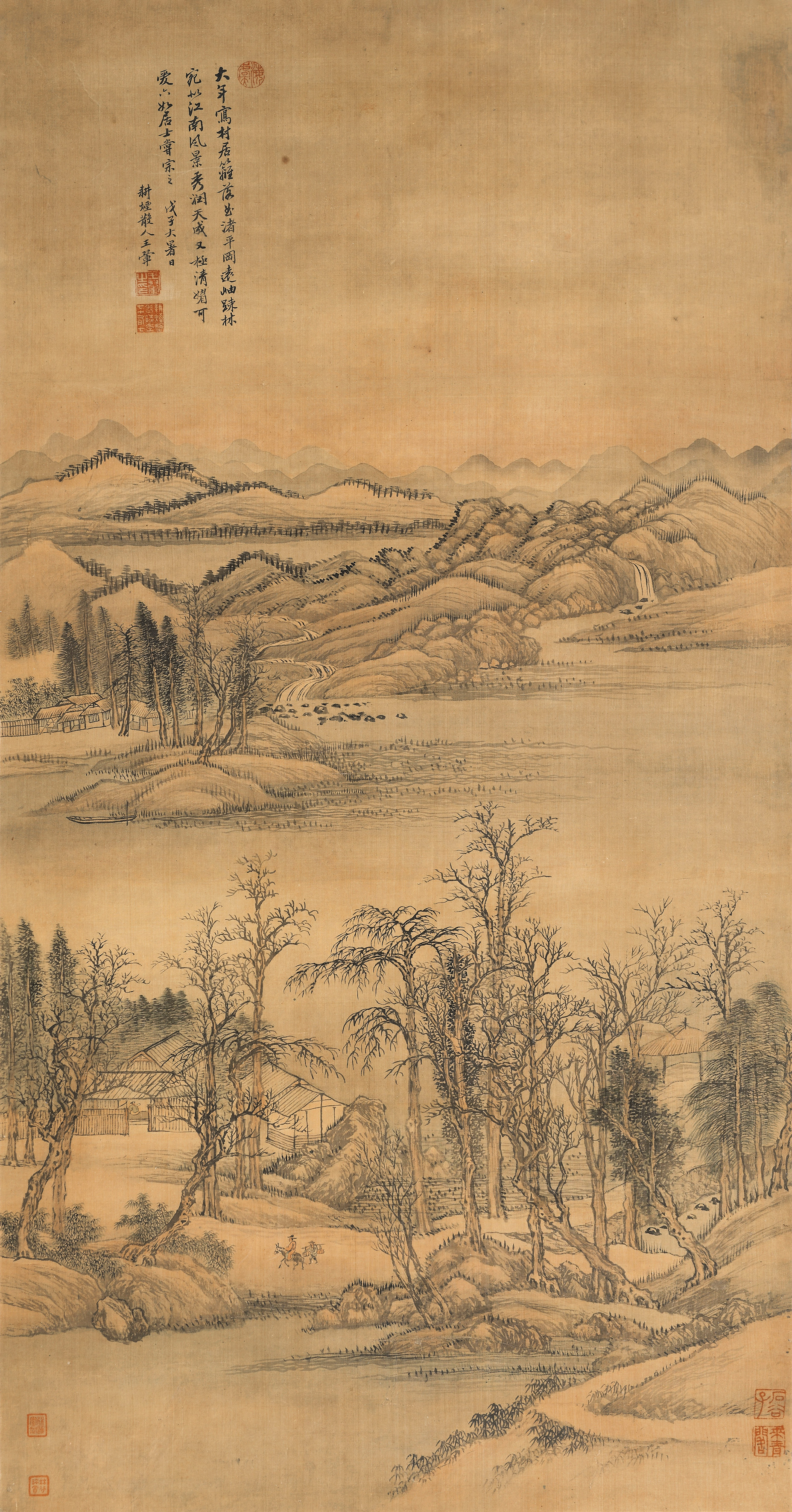
Wang Hui of the Qing Dynasty imitation of Liu Ru layman's landscape on silk, ink and color, 87.5cm×46cm
Over the years, while introducing and displaying Pan Tianshou's art, Pan Tianshou Memorial Hall has always been committed to building a bridge for academic research, that is, by opening the "small window" in art history, exploring the artistic issues concerned by famous historical figures, and thinking about the role of the ontology of art. For future development, we ask how to make excellent culture glow with lasting vitality today. The academic exhibition focuses on Liu Jiu'an's art appreciation and research path, which has far-reaching practical significance for promoting the construction of the theoretical system of calligraphy and painting appraisal disciplines, inheriting and carrying forward traditional Chinese painting art, and establishing national cultural confidence.
An academic seminar will also be held concurrently with the exhibition, inviting important domestic experts in the field of ancient calligraphy and painting appraisal and the younger generation of scholars to participate. Lou Wei, Executive Vice President of the Palace Museum, said: “On the occasion of the 30th anniversary of the establishment of the discipline, the Palace Museum and the China Academy of Art have jointly held a documentary exhibition in memory of Mr. Liu Jiu’an as an opportunity to reorganize and strive to present the discipline of ancient Chinese calligraphy and painting appraisal. We will carry forward the academic legacy left by our gentlemen and share it with society. This has important reference value for the study of the appraisal history of ancient Chinese calligraphy and painting and the study of art history."

exhibition site

This exhibition is co-sponsored by the China Academy of Art and the Palace Museum, and hosted by the Pan Tianshou Memorial Hall of the China Academy of Art and the Institute of Chinese Painting. The exhibition will last until January 12, 2024.

